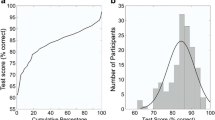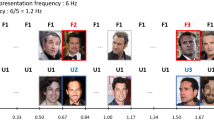Abstract
Several anatomo-clinical investigations have shown that familiar face recognition disorders not due to high level perceptual defects are often observed in patients with lesions of the right anterior temporal lobe (ATL). The meaning of these findings is, however, controversial, because some authors claim that these patients show pure instances of modality-specific ‘associative prosopagnosia’, whereas other authors maintain that in these patients voice recognition is also impaired and that these patients have a ‘multimodal person recognition disorder’. To solve the problem of the nature of famous faces recognition disorders in patients affected by right ATL lesions, it is therefore very important to verify with formal tests if these patients are or are not able to recognize others by voice, but a direct comparison between the two modalities is hindered by the fact that voice recognition is more difficult than face recognition. To circumvent this difficulty, we constructed a test battery in which subjects were requested to recognize the same persons (well-known at the national level) through their faces and voices, evaluating familiarity and identification processes. The present paper describes the ‘Famous People Recognition Battery’ and reports the normative data necessary to clarify the nature of person recognition disorders observed in patients affected by right ATL lesions.
Similar content being viewed by others
References
Gainotti G, Marra C (2011) Differential contribution of right and left temporo-occipital and anterior temporal lesions to face recognition disorders. Front Hum Neurosci 5:55. doi:10.3389/fnhum.2011.00055
Anzellotti S, Caramazza A (2014) The neural mechanisms fort he recognition of face identity in humans. Front Hum Neurosci 5:672. doi:10.3389/fpsyg.2014.00672
Mathias SR, von Kriegstein K (2014) How do we recognise who is speaking? Front Biosci (Schol Ed) 1(6):92–109
Bodamer J (1947) Die Prosopoagnosic. Archiv für Psychiatrie und Nervenkrankheiten 179(1–2):6–53
Van Lancker DR, Canter GJ (1982) Impairment of voice and face recognition in patients with hemispheric damage. Brain Cogn 1(2):185–195
Gainotti G (2011) What the study of voice recognition in normal subjects and brain-damaged patients tells us about models of familiar people recognition. Neuropsychologia 49(9):2273–2282. doi:10.1016/j.neuropsychologia.2011.04.027
Meudell PR, Northen B, Snowden JS, Neary D (1980) Long term memory for famous voices in amnesic and normal subjects. Neuropsychologia 18(2):133–139
Garrido L, Eisner F, McGettigan C, Stewart L, Sauter D, Hanley JR, Schweinberger SR, Warren JD, Duchaine B (2009) Developmental phonagnosia: a selective deficit of vocal identity recognition. Neuropsychologia 47(1):123–131. doi:10.1016/j.neuropsychologia.2008.08.003
Barton JJ (2008) Structure and function in acquired prosopagnosia: lessons from a series of 10 patients with brain damage. J Neuropsychol 2(Pt 1):197–225
Gainotti G (2014) Cognitive models of familiar people recognition and hemispheric asymmetries. Front Biosci 6:148–158
Hanley JR (2014) Accessing stored knowledge of familiar people from faces, names and voices: a review. Front Biosci 6:198–207
De Renzi E, Faglioni P, Grossi D, Nichelli P (1991) Apperceptive and associative forms of prosopagnosia. Cortex 27(2):213–221
Ellis AW, Young AW, Critchley EM (1989) Loss of memory for people following temporal lobe damage. Brain J Neurol 112(Pt 6):1469–1483
Hanley JR, Young AW, Pearson NA (1989) Defective recognition of familiar people. Cogn Neuropsychol 6:179–210
Bruce V, Young A (1986) Understanding face recognition. Br J Psychol 77(Pt 3):305–327
Nakachi R, Muramatsu T, Kato M, Akiyama T, Saito F, Yoshino F, Mimura M, Kashima H, Pancaroglu R, Busigny T, Johnston S (2007) Progressive prosopagnosia at the very early stage of frontotemporal lobar degeneration. Psychogeriatrics 7:155–162
Pancaroglu R, Busigny T, Johnston S, Sekunova A, Duchaine B, Barton JJS (2011) The right anterior temporal lobe variant of prosopagnosia. J Vis 11(11):573. doi:10.1167/11.11.573
Williams MA, Savage G, Halmagyi M (2006) Abnormal configural face perception in a patient with right anterior temporal lobe atrophy. Neurocase 12(5):286–291. doi:10.1080/13554790601026379
Gainotti G (2013) Is the right anterior temporal variant of prosopagnosia a form of ‘associative prosopagnosia’ or a form of ‘multimodal person recognition disorder’? Neuropsychol Rev 23(2):99–110. doi:10.1007/s11065-013-9232-7
Boudouresques J, Poncet M, Cherif AA, Balzamo M (1979) Agnosia for faces: evidence of functional disorganization of a certain type of recognition of objects in the physical world. Bulletin de l’Academie nationale de medecine 163(7):695–702
Gainotti G, Barbier A, Marra C (2003) Slowly progressive defect in recognition of familiar people in a patient with right anterior temporal atrophy. Brain 126(Pt 4):792–803
Benton AL, Van Allen MW (1968) Impairment in facial recognition in patients with cerebral disease. Trans Am Neurol Assoc 93:38–42
Gainotti G (2007) Face familiarity feelings, the right temporal lobe and the possible underlying neural mechanisms. Brain Res Rev 56(1):214–235. doi:10.1016/j.brainresrev.2007.07.009
Rapcsak SZ, Polster MR, Comer JF, Rubens AB (1994) False recognition and misidentification of faces following right hemisphere damage. Cortex 30(4):565–583
Rapcsak SZ, Polster MR, Glisky ML, Comer JF (1996) False recognition of unfamiliar faces following right hemisphere damage: neuropsychological and anatomical observations. Cortex 32(4):593–611
Young AW, Flude BM, Hay DC, Ellis AW (1993) Impaired discrimination of familiar from unfamiliar faces. Cortex 29(1):65–75
Hailstone JC, Crutch SJ, Vestergaard MD, Patterson RD, Warren JD (2010) Progressive associative phonagnosia: a neuropsychological analysis. Neuropsychologia 48(4):1104–1114. doi:10.1016/j.neuropsychologia.2009.12.011
Spinnler H, Tognoni G (1987) Standardizzazione e taratura di test neuropsicologici. Ital J Neurol Sci 8:1–120
Orsini A, Grossi D, Capitani E, Laiacona M, Papagno C, Vallar G (1987) Verbal and spatial immediate memory span: normative data from 1355 adults and 1112 children. Ital J Neurol Sci 8(6):539–548
Liu RR, Pancaroglu R, Hills CS, Duchaine B, Barton JJ (2014) Voice recognition in face-blind patients. Cereb Cortex. doi:10.1093/cercor/bhu240
Gobbini MI, Haxby JV (2007) Neural systems for recognition of familiar faces. Neuropsychologia 45(1):32–41. doi:10.1016/j.neuropsychologia.2006.04.015
Blank H, Wieland N, von Kriegstein K (2014) Person recognition and the brain: merging evidence from patients and healthy individuals. Neurosci Biobehav Rev 47:717–734. doi:10.1016/j.neubiorev.2014.10.022
Hanley JR, Smith T, Hadfield J (1998) I recognise you but I can’t place you: an investigation of familiar-only experiences during tests of voice and face recognition. Quart J Exp Psychol 51:179–195
Barsics C, Bredart S (2011) Recalling episodic information about personally known faces and voices. Conscious Cogn 20(2):303–308. doi:10.1016/j.concog.2010.03.008
Acknowledgments
The authors would like to thank Dr. Antonia Ferrara and Dr. Natascia Guarino for their precious help in data gathering.
Author information
Authors and Affiliations
Corresponding author
Ethics declarations
Conflict of interest
The authors declare that they have no conflict of interest.
Electronic supplementary material
Below is the link to the electronic supplementary material.
Rights and permissions
About this article
Cite this article
Quaranta, D., Piccininni, C., Carlesimo, G.A. et al. Recognition disorders for famous faces and voices: a review of the literature and normative data of a new test battery. Neurol Sci 37, 345–352 (2016). https://doi.org/10.1007/s10072-015-2437-1
Received:
Accepted:
Published:
Issue Date:
DOI: https://doi.org/10.1007/s10072-015-2437-1




